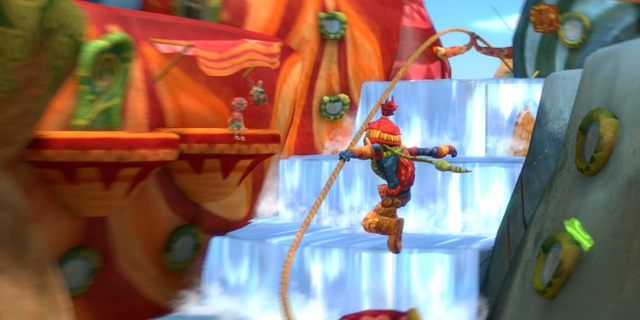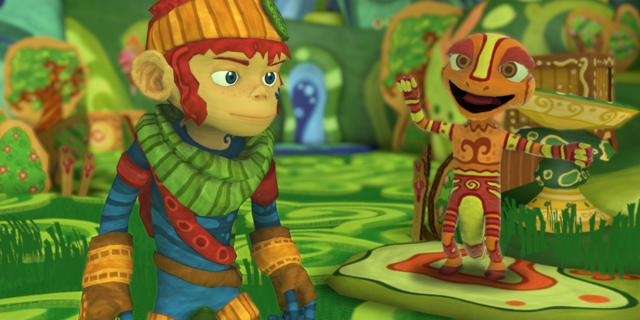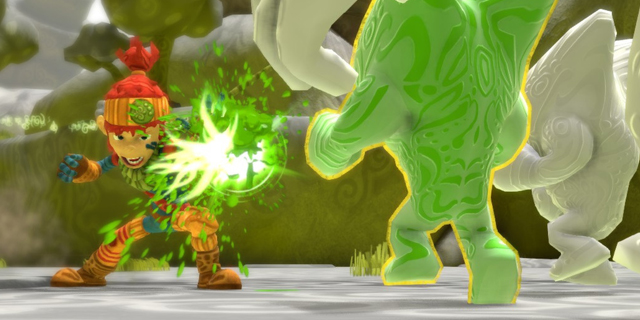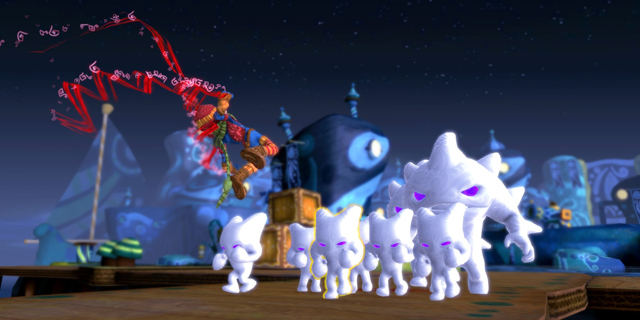
The Nintendo 64 had a lot going for it, but possibly its best development was the advent of the 3D platformer. Between Super Mario 64, Banjo-Kazooie and Conker’s Bad Fur Day, the genre got a great start. There’s something great about colorful worlds to explore and interesting mechanics used to save the world, and The Last Tinker looks and feels like a visual upgrade to those greats of generations past.
You play as Koru, a multi-colored monkey-boy in a world otherwise populated by monochromatic animals. The different colored animals all have different jobs to do, and they depend on one another to create the things that they all need to make Color World a great place to live. At the start of the game, however, something has gone wrong, and a malevolent force has started to drain everybody’s color. Koru discovers that he is a Tinker, one who can wield the powers of the color spirits, and so he sets off to restore pigment to the world, save his friends and pick up whatever collectibles might be laying around.

The game’s varied activities include timed traversal, jumping over obstacles on grind rails, participating in fights, fertilizing mushrooms, escorting citizens to safety and sneaking past security guards. What really sells it, though, is the wonderful aesthetic and Mimimi’s complete devotion to it. Everything in Color World is made of cardboard, paint and glue. The whole world, including Koru’s pet sheep, Tap, evoke memories of Viva Pinata. Bushes are drawn on cardboard and set down on the ground. They are two-dimensional and look like they were drawn and colored by a child, and you can see the corrugation when viewing them from the side. Little touches like these make the whole world feel like a children’s storybook, endearing the player to it, and it makes it that much more important to complete objectives, drive back the encroaching bleakness and save the world.
Koru even teaches good lessons to game players. Early on, he takes part in a race with some Red citizens, including his nemesis who cheats and wins the race. After the bleakness comes, Koru’s first stop is the Red District to start returning color to the world, and who should he find in need of help but the very same person who just cheated him out of a victory a mere 30 minutes ago. Koru and Tap help him and his gang by restoring color to the Red District, and then restore color to individuals who are frozen in place.

Each district results in Koru acquiring a new power, and the opening teaches him how to fight. There is also a vending machine in the center hub, where Koru can purchase health upgrades and new combat moves. Combat feels like a simpler Batman: Arkham Asylum affair, complete with exclamation point indicators when an enemy is going to attack, chaining a dodge into an attack on another enemy and performing ground-clear attacks after getting a high enough combo score. Koru is no slouch when it comes to knocking around the bleak enemies, and the game’s generous lock-on ensures that you’ll never be needlessly striking at the air instead of connecting with a hostile unit.
That said, The Last Tinker is very easy to complete. Koru starts with a good amount of health and that base amount can be augmented throughout the adventure, and combat is simple to master thanks to only having one attack button and enemies that aren’t too aggressive. Jumping is handled automatically, so you’ll never attempt a jump you can’t make, and puzzles aren’t terribly complex. The automatic jumping do make for some impressive-looking runs over a set of octopus legs to dodge projectiles, up a set of vines to a ledge and then down a cargo line to safety. And the simpler system is easier for younger gamers to pick up.

The Last Tinker: City of Colors is easy to recommend, especially if you have young gamers in your life, some nostalgia for the old days of 3D platforming or both.
Pros: Beautiful cardboard diorama aesthetic, surprisingly deep combat system
Cons: Very forgiving in all regards, trades challenge for flash in traversal



















